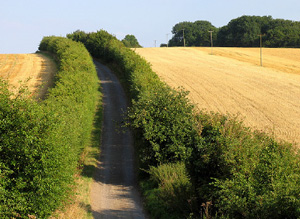This is the Winterbourne valley and areas of the high downs formed by watersheds between the Lambourn, Winterbourne and Pang rivers.
Iron Age activity is quite widespread and includes cropmarks of nine banjo enclosures. There is also significant evidence of Romano- British activity including Roman settlements. Important evidence for early Medieval settlement survives at Chieveley, Chaddleworth Fawley, Winterbourne and Leckhampstead, Catmore and Beedon. Large and coherent areas of early enclosures remain across much of the area. This has preserved evidence of the grain of the 15th to 19th century historic landscape of the AONB.
North Wessex Downs AONB HLCA Extract 9
Present Day Historic Landscape Character

The development of mechanised farming over the latter half of the 20th century led to substantial change in the area with most fields being heavily altered and the remaining areas of open field and downland enclosed. However, the reorganisation of the landscape has been less complete than in other parts of the AONB, and large and coherent areas of early enclosures remain across much of the area. Unlike surrounding areas, most field alteration has been through amalgamation of fields by boundary removal as opposed to re-organisation and insertion of new boundaries. This has preserved some of the grain of the historic landscape and, in many cases, traces of removed boundaries remain.
Existing woodland has had a mixed history; much seems to have survived but several large blocks of ancient woodland have been cleared for agriculture. This is largely a later 20th century phenomenon; however, one wood was cleared in the late 19th century. Ancient woodlands at Brightwalton and Catmore have been cleared of native tree cover and replanted with other species. There has been a small growth in new tree-cover, mostly linear shelter plantations around Catmore.
All parks survive in some form in the landscape but large portions of parkland have come under arable cultivation. The adjoining parks at Priorscourt and Bradley have seen most change. All of Priorscourt Park is now under different usage, the grounds mainly under arable cultivation and the house itself used a school. Bradley Park is now a small stub around the house and the rest of the grounds are fields.
Layers in the Landscape

Iron Age activity is quite widespread and includes cropmarks of nine banjo enclosures. An enclosed settlement, formed by three banjo enclosures, exists at Wellhill Road in the West of the area and in the East of the area Iron Age occupation has been found during excavations at Oareborough Hill, Stanmore and World’s End. Patches of cropmarks of later prehistoric/Romano-British field systems exist across the area but become scarcer in the upper part of the valley.
An early Romano-British farmstead with some evidence of burials was also partially excavated at Chieveley prior to road construction. A rectangular cropmark exists South-East of Chaddleworth and field walking on site has produced Roman coins and pottery. Evidence of settlement of this period has been found during excavations at Stanmore, World’s End and Oareborough Hill. The Iron Age settlement at Oareborough Hill was re-occupied during the late Roman period and it has been suggested, on the basis of finds and cropmarks, that a villa exists a short distance to the North of this settlement. Evidence of Romano-British buildings was also found during the 19th century at Stanmore Farm and Beedon Brickworks.
There is evidence for early Medieval settlement at Chieveley, Chaddleworth Fawley, Winterbourne and Leckhampstead. Leckhampstead is recorded as having a church in 1050 and the site of this was at Chapel Farm. But other evidence of early Medieval activity is quite scarce. In both Winterbourne and Lechampstead settlement seems to have migrated from its original location around the church.
Most late Medieval evidence comes from buildings including churches and farmstead. Three deserted Medieval villages, Whatcombe, Henley and Woolley are recorded. Earthworks at Bussock Court have been interpreted as a manorial site mentioned in the 16th century. In the East of the area a deer park, established in the 14th century, existed immediately South-West of Beedon and elements of the park, such as at Park Copse, are still visible in the landscape.
Like neighbouring downland areas, the Medieval landscape was composed of communities within open fields utilising common grazing on adjacent or nearby downland. Commons existed at Chaddleworth, Beedon and Rowbury, but these were not frequent features of downland areas. Most of the open field and some downland had been enclosed into private fields by the start of the 18th century.
The majority of remaining open fields, commons and downs were enclosed into fields through Act of Parliament in the early 19th century, and large areas of Parliamentary fields existed in Chaddleworth, Chieveley and Beedon. Some open field and larger areas of downland around Fawley and South Fawley remained unenclosed into the 20th century.
Historic Settlement Character

The historic settlement pattern was mixed and consisted of a few nucleated villages and a larger number of hamlets and farms; some dispersed types of settlement were also present. The villages (Farnborough, Brightwalton, Peasemore and Chieveley) were located on the valley slopes on ridges overlooking the valley floor. Hamlets were widely scattered across the area but were a varied group containing small hamlets, such as Fawley and Catmore, and settlements consisting of multiple foci, such as Beedon, Leckhampstead and Bothampstead. Many parishes, such as Chaddleworth and Beedon, had no main central settlement but a series of small related hamlets instead. Red brick was the commonest building material with many thatch buildings also surviving.
Historic Farmstead Character
Farms were common across the centre of the area and most were named after topographic features or the nearest settlement. There is a low to medium concentration of pre-1750 farmstead buildings.



